Contents
Fences for flowerbeds not only give them a compositional completeness, they divide the site into functional zones, at the same time combining it into one landscape complex. They also have a purely utilitarian function of protecting flower beds, beds and lawns from children and pets, dug into the ground additionally protect the roots of plants and prevent the spread of weeds around the site. A variety of types of fences for flower beds from all possible materials are used. Stores offer ready-made products, but many summer residents prefer to make them with their own hands.
stone fence
The height, appearance and material of manufacture of fences is determined by their function. If this is a decorative fence, it can be no higher than 5-7 cm, it can be made from whatever the owner wishes. A border around beds or lawns can be made 10–15 cm high. Stone fences for flower beds can solve purely decorative tasks, for example, it is easy to lay out beautiful stones around the perimeter of a flower bed with your own hands to simply indicate its boundaries. You can stack flat stones around flower beds or beds on top of each other, they will only hold on to gravity.
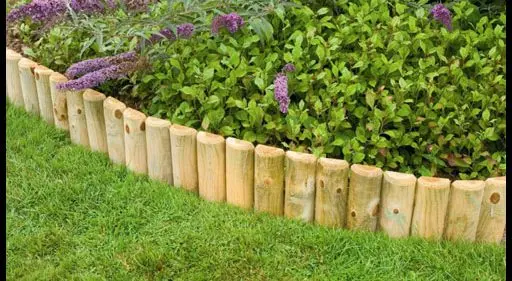
If they want to organize a permanent flower garden, which will always be in one place, then it is worth digging a groove, making a foundation of cement, and installing a stone wall of the desired height on it. In this case, the first row of stones should be slightly sunk into the cement, then lay out the next level of large stones on top, insert small stones between them, closing all the cracks, fasten it all with cement. Such a strong border is built for raised beds, consisting of one or more levels.
With their own hands, they often build a fence made of bricks or paving slabs. Bricks are simply stacked on top of each other in a checkerboard pattern, without fastening anything – this way you can achieve any degree of curvature, bending around the flower garden around the perimeter. For a more serious fence, laying is done, fastening the brick with mortar. Such a fence can be planted on the foundation, then it will restrain the spread of weeds. Some summer residents recall the experience of their grandmothers, marking the border of the flower garden with a brick dug in to half. A shallow ditch is dug along the border, a brick is placed at a corner, the same one is attached to it, and this brick tape is held by the earth trampled on the sides.
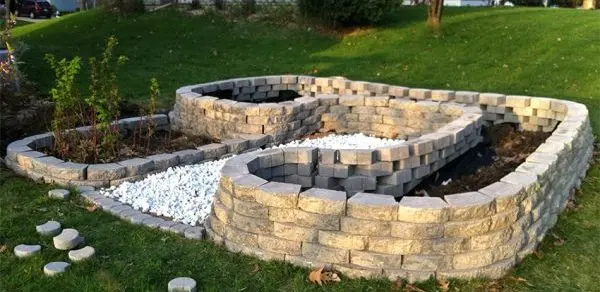
Paving slabs are convenient for decorative work with their small size. It is easy to make a solid wall of any shape, size, color from it. It is easy to work with it, it is suitable for decorating even the smallest flower beds.
Garden fences made of stone are the most expensive, but their beauty, strength, durability are worth the money, effort and time spent. In addition, other materials are perfectly combined with stone.
Video “A selection of options for flower beds”
Video selection of several options for fences for flower beds.
Of wood
Wooden fences for flower beds, lawns and garden beds are the most common. This is understandable: wood is a natural material that looks organically on a garden plot, does not heat up, does not injure plants, and does not require special skills or abilities to work. If you make a fence with your own hands, then not only new wood will be used, but even any waste, which there is always a lot in the country. The forms of such barriers are various:
- any flat sticks become a type-setting picket fence;
- buried pegs turn into a curb;
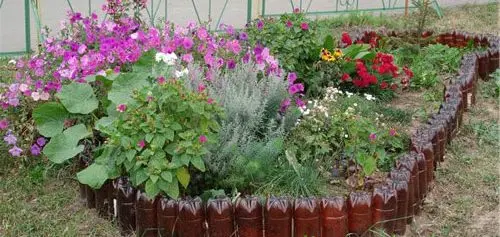
- fences are made from stacked logs;
- wicker fences are created from branches;
- cross-sawn logs are dug in vertically or laid out in flat paths.
The only drawback of wooden products is fragility. Air, water and the sun by constant influence slowly destroy them. But there are special tools, the processing of which extends the period of their operation.
If you pick up logs of the same size, you can protect the flower bed with them by simply digging around the perimeter. The logs are cleaned of bark, treated with an antiseptic, a ditch 20 cm deep is dug along the flower bed, wooden blanks are tightly placed on the bottom, covered with earth, and tamped. The logs are buried to a depth of 20 cm, which means that their size is the height of the fence + 20 cm. If the part that is buried in the ground is wrapped with roofing material, it will last longer. With such precautions – roofing felt + antiseptic – this fence will last at least 10 years.
Of metal
Metal fences for flower beds are the most durable, but also the most expensive when it comes to custom-made forged or cast lattices. Even fences welded from metal rods can be very beautiful, they can simultaneously (or specifically) serve as a support for climbing plants. If wood and stone look organically on their own in garden plots, then metal products must still fit into the overall design, and only a metal craftsman can create them with their own hands.
Some use finished metal products in the country. For example, pipes of different diameters are dug in along the perimeter of flower beds or beds, filled with earth, ampelous or climbing plants are planted in them, hanging down with lashes. This is how very beautiful compositions are obtained, which at the same time are a hand-made fence.
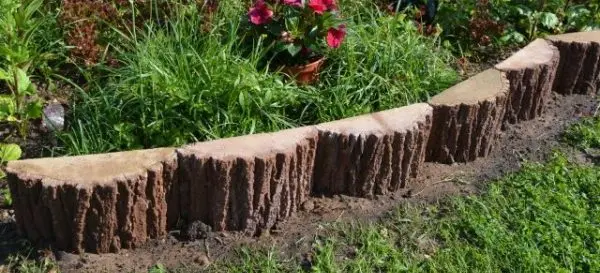
Plastic
Shops offer a huge variety of plastic fences for flower beds, beds or lawns. They, as a rule, consist of separate modules that are easily assembled and fixed in the ground, they are very easy to transport and install with your own hands. Plastic is indifferent to the effects of water, wind and sun, it is durable and undemanding. In addition, it can easily imitate wood or stone, fences from it can be selected for every taste, used anywhere in the garden, and if necessary, simply removed from the ground and moved to another place.
In addition to all kinds of sectional fences equipped with special pegs (which keep them in the ground), curb tape is sold. It is flexible, sold in rolls, it can enclose flower beds or beds of any shape. The tape can be smooth or textured, it can imitate brickwork or tree bark. A groove is dug around the perimeter of the flower beds, the edge of the curb is lowered into it, buried, and rammed. Its width is different, it can be buried at different depths depending on the purpose: for a purely decorative purpose – a few centimeters, so that it only holds, and to protect the roots or contain weeds – deeper. All this is very easy to do with your own hands.

Cellular polycarbonate or profiled plastic sheets are also used as fencing. Only they will have to be glued with building glue or sealant. Plastic fences can be deformed due to mechanical influences: they can be knocked down by children, dogs, washed away by heavy showers. But they are not damaged at the same time, so it is easy to restore the barrier.
Handy materials
Very often, do-it-yourself fences for flower beds or beds in summer cottages are simply made from improvised materials. What is a pity to throw away is always brought to the dacha: old furniture, things, utensils. In addition, somewhere in the barn, the remnants of materials from the last repair are certainly stored. All this can decorate a summer cottage, make it original and unique.
Cute fences will turn out if you stick old vinyl records or plates left over from various services into the ground along the perimeters of the beds. A grateful material for decorating summer cottages is old car tires. They make both the simplest flower beds and complex multi-tiered structures. If you just bury the tires in a vertical position around the beds, you get a simple but reliable fence. Having cut out the middle, soil is poured into the remaining rubber ring and flowers or vegetables are planted. Having cut the pattern and turned the tires inside out, they create vases with or without a leg, swans or outlandish birds, on the backs of which flowers grow. Tires are used to make whole compositions representing different animals or tea-drinking utensils in which vegetation lives.

And if you cut out the outer side with the tread, you get a wonderful flexible curb tape, the segments of which will need to be connected with rubber glue. Tires are useful for protecting young trees or bushes growing in the middle of the lawn. Such a fence can protect the plant from a lawn mower or a children’s bike.
The simplest fence that you can create with your own hands is made from bottles. Plastic or glass bottles are suitable for this. They just need to be buried around the perimeter of the flower bed with their necks down. Plastic bottles for stability and shape retention are filled with bulk materials – earth, sand or small pebbles. If you cut off the necks of plastic bottles and insert them one into the other, you get a kind of long snake that wraps itself around the garden. Only for stability it will also need to be filled with sand and slightly dug.
Plastic bottles are easy to cut, and it is convenient to make a fence out of their parts, like plastic modules, sticking into the ground. To do this, they take bottles of the same size, cut off the bottom, cut out and slightly bend the edges in the form of petals, and stick their necks into the ground. It turns out a fence of plastic flowers.
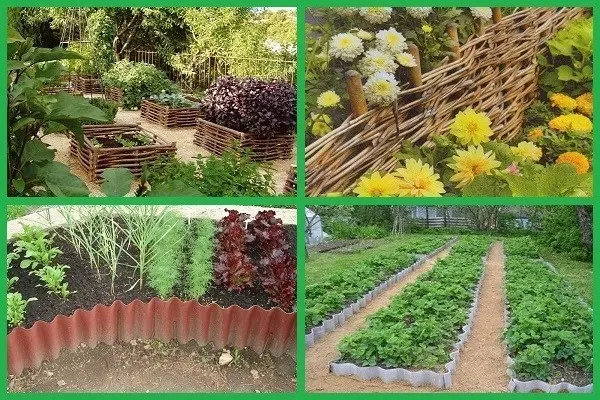
Raised flower beds are made from whole bottles, often glass. They are placed around the perimeter of the flower bed, fastened together with cement mortar in several rows. Vases with wide (bottle length) walls are obtained. In this way, high multi-tiered flower beds are arranged, the main thing is to collect more bottles.
Video “Ways to protect a flower bed”
Demonstrative video with recommendations for self-creation of fences.









